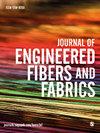The effect of ultrasound on environmentally extraction and dyeing of wool yarns
IF 2.3
4区 工程技术
Q1 MATERIALS SCIENCE, TEXTILES
引用次数: 6
Abstract
Reducing pollution in various industries such as textile is very important. In this paper, two parallel methods were used to reduce pollution of the process and application of dye. The first approach was the selection of plant-based dyes (Madder with the botanical name of Rubia tinctorum and Reseda with botanical name of Reseda odorata) and the application of a tannin-based mordant (pomegranate peel with botanical name of Punica granatum). The second approach was extraction and dyeing in ultrasound media. The extraction efficiency of madder, Reseda, and pomegranate peel in water with the ultrasound-assisted method was 23%, 33%, and 29%, respectively. In this paper, the meta-mordanting method was used for mordanting procedure, and to compare the results, Cu (copper) was selected as the mineral mordant. Extracts were identified by FTIR method. Yarns’ changes in the process of mordanting and dyeing are investigated using two methods, FTIR and SEM. The effect of changing the concentration of mordant and dyes with the amount of K/S were evaluated and the K/S value of dyed samples illustrated that increasing the dye concentration of the dye increases the amount of K/S. The color fastness properties of all samples were investigated using the ISO standards.超声波对毛纱环保提取染色的影响
减少诸如纺织等行业的污染是非常重要的。本文采用两种并行的方法来减少染料的生产过程和使用过程中的污染。第一种方法是选择基于植物的染料(植物名称为Rubia tinctorum的Madder和植物名称为Reseda odorata的Reseda)和基于单宁的媒染剂(石榴皮,植物名称为Punica granatum)的应用。第二种方法是超声介质提取染色。超声波辅助提取水中茜草、芦笋、石榴皮的提取率分别为23%、33%、29%。本文采用超媒染法进行媒染法处理,并对结果进行比较,选择铜(Cu)作为矿物媒染剂。用FTIR法对提取物进行鉴定。采用傅里叶变换红外光谱(FTIR)和扫描电镜(SEM)两种方法研究了纱线在染整和染色过程中的变化。考察了染发剂和染料的浓度随K/S的变化对染色样品的K/S值的影响,染色样品的K/S值表明,染料浓度的增加会增加K/S的量。采用ISO标准考察了所有样品的色牢度特性。
本文章由计算机程序翻译,如有差异,请以英文原文为准。
求助全文
约1分钟内获得全文
求助全文
来源期刊

Journal of Engineered Fibers and Fabrics
工程技术-材料科学:纺织
CiteScore
5.00
自引率
6.90%
发文量
41
审稿时长
4 months
期刊介绍:
Journal of Engineered Fibers and Fabrics is a peer-reviewed, open access journal which aims to facilitate the rapid and wide dissemination of research in the engineering of textiles, clothing and fiber based structures.
 求助内容:
求助内容: 应助结果提醒方式:
应助结果提醒方式:


